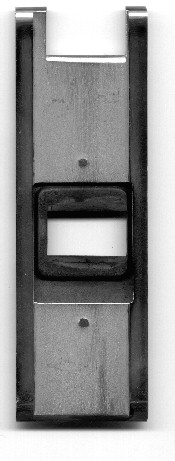
The masks in the picture are part of my projector at home. You see the Normal and the WideScreen masks. (Which mask for what format? Perhaps you can tell by now.)
 |
Two filmmasks. They are used to limit the area of film which is
exposed to the projection light beam. Normally the size of the opening is
a little bit less the total exposed film frame during shooting of the
film. In case this area is not proper aligned or not matching the screen
aperture in the theatre you will be distracted from the picture by e.g. a
projected sound track, projected perforation, images partly projected on
the walls or ceilings of the theatre or by vague borders on the white
projection screen. The masks in the picture are part of my projector at home. You see the Normal and the WideScreen masks. (Which mask for what format? Perhaps you can tell by now.) |
| Format | relative size | aperture size in mm |
| Normal | 1 : 1.37 | 15,2 : 20.9 |
| Widescreen 1.66 | 1 : 1.66 | 12.6 : 20.9 |
| Widescreen 1.75 | 1 : 1.75 | 11.9 : 20.9 |
| Widescreen 1.85 | 1 : 1.85 | 11.3 : 20.9 |
Cinemascope Optical sound |
1 : 2.35 | 18.2 : 21.3 |
| Cinemascope magnetic sound |
1 : 2.55 | 18.2 : 23.4 |
| Cinemascope Combi print |
1 : 2.35 | 18.2 : 21.3 |
| Superscope | 1 : 2 | 18.2 : 18.2 |